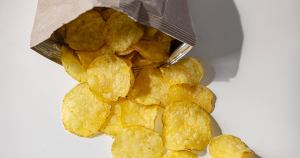
It’s a common question when you buy lots of fresh vegetables to accommodate a colorful, healthy diet: how long will these stay good? As the variety of veggies you’ve stocked all have different expiration dates, it becomes a challenge to buy certain ingredients based on which night of the week you will need it to prepare your meal. You’ve probably gone to the fridge one evening to prepare your favorite Kale and Brussels Sprouts Salad to find that your kale has wilted and maybe gone a bit slimy. Little hiccups like this can be super inconvenient and that’s why it’s important to know the shelf life of fresh vegetables, especially when you’re creating your grocery list. Here are some helpful tips for the most popular vegetables you like to use. (via Ranker)
Potatoes: Most potatoes can last up to five weeks. Red, new, or Yukon gold potatoes will only last about three weeks. Discoloration and growths through the skin are a sign that the potato is going bad. Usually you can cut off new sprouts, but it won’t be as flavorful. Keep potatoes dry or they will start to mold, so don’t wash them prior to storing them. Storage tip: Store in a cool, dark, dry place.
Videos by PopCulture.com
>> Try this recipe: Skinny Rosemary Parmesan Oven Potatoes
Carrots: Fresh carrots, depending on if they are baby carrots or whole, can last up to five weeks. Whole carrots still have their skin so they will last longer. If they become mushy or slimy, throw them out. Storage tip: Store in their original plastic bag.
Sweet corn: Fresh corn lasts for up to one week. You can tell whether or not it’s beginning to spoil by the tips. If it’s dark and mushy, it’s going bad. Don’t leave corn out on the counter or it will lose flavor. Storage tip: Keep husk attached and store in cool, dry space.
Broccoli: Fresh broccoli can last up to two weeks if stored properly. You know it’s going bad when the smell is stronger; it starts to wilt and turn a bit yellow. Storage tip: Store in a sealed plastic bag.

>> Try this recipe: Skinny Chicken Broccoli Casserole
Tomatoes: Fresh tomatoes last one week if left out on the counter and two weeks if stored in the refrigerator. If they start leaking liquid or get soft, toss them. Storage tip: Store at room temperature for the best flavor. Check out these awesome tomato recipes.
Lettuce: A head of fresh iceberg or romaine lettuce lasts for seven to 10 days. If it begins to change color, wilt or adopt a bad smell, toss it in the trash. Rinse and dry your lettuce before you store it to make it crisper. Storage tip: Leave in plastic bag.
>> Try these 12 Mason Jar Salads for fun, fresh ways to use your lettuce.
Onion: Onions will last up to six weeks if left out but will last several months if you refrigerate them. Once you’ve chopped them, put them in the fridge and they will last about one week. Keep an eye out for soft spots and discoloration. It could be mold and you will want to cut those parts away and use the onion quickly. Storage tip: Store in a cool, dry, open space.
Garlic: Fresh, whole garlic will last up to six months while single cloves will last one or two months. If you buy the pre-chopped garlic in a jar, that needs to be refrigerated and will last two to three months. Brown spots or change in color to a dark yellow or tan indicate that the garlic is going bad. Storage tip: Store in a dark, cool spot.
>> Try this recipe: Cheesy Garlic Porkchops
Green beans: Fresh green beans will last up to 10 days if refrigerated. If you want to freeze them, make sure you cook them first. A sour smell and white colored liquid are indicators that the beans have gone bad. Storage tip: Store in a plastic bag.
Cucumber: Fresh cucumbers last about one week if stored whole. If you’ve already sliced them, they should stay good for a couple days if you refrigerate them. Soft spots and wrinkled skin indicate aging so toss them in the trash. Storage tip: Buy waxed cucumbers if you want them to last a week or more.
Spinach: Fresh spinach can last three to five days. If you haven’t opened the container yet, it will last about one week. If it’s beginning to get dark and moist, you won’t want to eat it. Keep it dry by using a salad spinner before you store it. Storage tip: Store in sealed bag or container in cool, dry space.

Sweet potatoes: These will last three to five weeks if stored in the pantry and about three months if kept refrigerated. Discoloration and softness tell you that you might want to toss them out. Storage tip: Store in a cool, dry place for maximum shelf life.
>> Click here for over 30 ways you can cook with sweet potatoes.
Bell pepper: Fresh, green bell peppers will last three weeks refrigerated but red bell peppers may only last for two weeks. If cut, peppers will only last a couple days. Make sure they’re firm. Softness indicates that they’re going bad. Storage tip: Store in a plastic bag.
>> Try this recipe: Skinny Cheesesteak Stuffed Peppers
Celery: Whole, fresh celery can last several weeks, but packaged celery will only last for three days or so. Softness and lighter coloration indicate that you shouldn’t use it. Storage tip: Store in a plastic bag.
Cauliflower: Fresh cauliflower lasts one to three weeks if refrigerated. If it starts to get brown spots or slimy, throw it out. Sometimes you can cut off the brown spots and still use it if you catch it soon enough. Storage tip: Store stem-side up in a plastic bag.
Information on how to store fresh vegetables along with the length of their shelf life can be found at Eat By Date. Get familiar with your fresh veggies so you can use every last bit of what you buy at the grocery. Oh My Veggies has a printable guide that you can take with you. Proper storage is also important to keeping your family healthy and making sure they get all the nutrients from their food. Check out this article about pickling vegetables and what you can do with them to really get creative with your food.
>> Read more: 12 Healthy Salads That Actually Fill You Up





